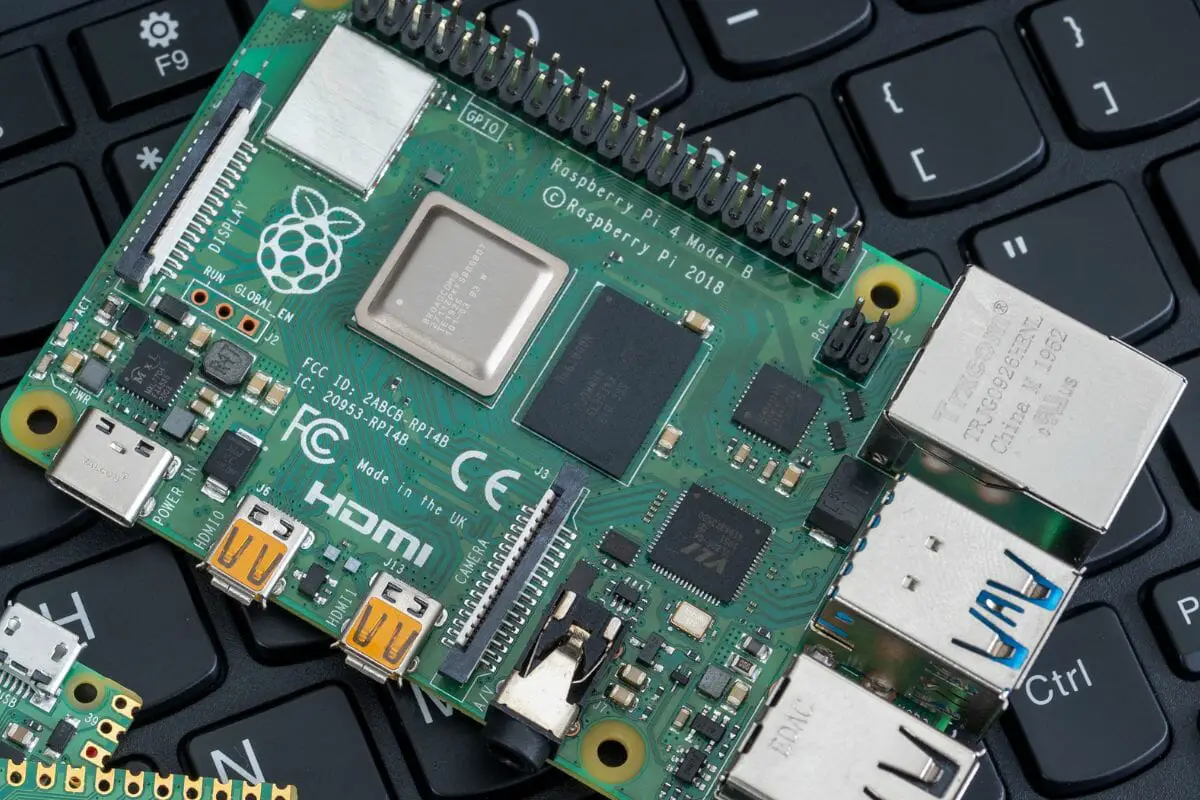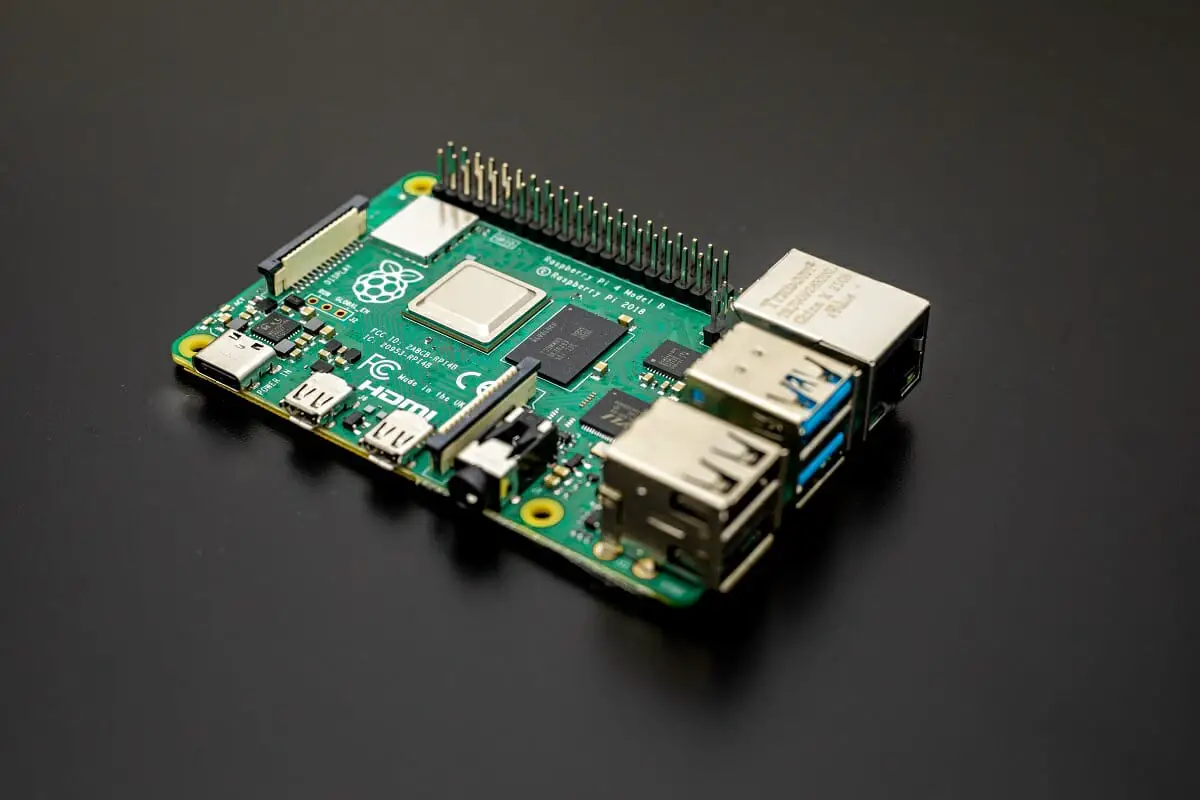Raspberry Pi is well known for making affordable but high-performing computer boards, allowing anyone to access a computer as long as they have some kind of monitor or screen.

Their latest model, the Raspberry Pi 4, has seen great success and on its heels has come the Compute Module 4 – but what is it and what can you do with it?
If you want to learn more about the Raspberry Pi Compute Module 4, then this is the place for you. We are going to be taking a look at everything relating to the Raspberry Pi Compute Module 4 including its specifications, uses, and additional products you can integrate it with.
What Is The Raspberry Pi Compute Module 4?
A lot of people have heard of the traditional Raspberry Pi computer board series and how it can be used for a range of applications and purposes – gaming, robotics, programming, etc. However, it’s easy to get this product mixed up with Raspberry Pi’s Compute Module series.
Raspberry Pi’s Compute Module series first began once the company noticed how many of its customers were using the original Raspberry Pi board for embedded systems.
However, using the Raspberry Pi for this purpose came with some difficulties including the high cost and trying to fit the desired system to the Raspberry Pi board’s unique I/O requirements and form factor.
To help make this easier, the Raspberry Pi company released the Compute Module – a specially designed board that is specifically made for custom devices.
It’s more affordable and has a much more flexible form factor that does not include the unique I/O requirements of the Raspberry Pi board. However, it still features a Raspberry Pi core.
As a result, a lot of people refer to the Compute Module series as ‘shrunken down’ Raspberry Pis or have also compared them to the Raspberry Pi Zero, but these are too vague a description and comparison.
Not only are the Compute Module products smaller than the original Raspberry Pi, but it’s easier to pair with different hardware thanks to their different form factor design.
Like most of Raspberry Pi’s products, the Raspberry Pi Compute Module 4 will eventually become obsolete.
This means that Raspberry Pi will eventually stop producing the Raspberry Pi Compute Module 4 as it will become outdated, although there will be newer Raspberry Pi products that will continue to build on what the Raspberry Pi Compute Module 4 has achieved.
The current obsolescence statement from Raspberry Pi is that the Compute Module 4 will continue production until January 2028 at the least.
What Can The Raspberry Pi Compute Module 4 Be Used For?
Due to its design, the Raspberry Pi Compute Module 4 can basically be used for anything the Raspberry Pi can. The whole reason why the Compute Module version exists is so customers can add it easily to their hardware and setup.
However, the capabilities of the Raspberry Pi Compute Module 4 all come down to one factor – the carrier board you integrate it with.
The potential of the Raspberry Pi Compute Module 4 is entirely dictated by the carrier board. Some example uses include processing automation, providing digital signage, and remote desktops.
The Compute Module 4 is designed for industrial applications and embedded systems (like televisions or handheld devices) more than anything else – hence why it’s designed to be so flexible.
But, overall, you can use it the same as a Raspberry Pi provided you integrate it with the right carrier board for your needs.
This means you can also use the Raspberry Pi Compute Module 4 for activities such as streaming media, retro gaming, programming, website building, cryptocurrency mining, and so much more – but most customers use their Raspberry Pi Compute Module 4 for more industrial applications as mentioned above.
Raspberry Pi Compute Module 4 Specifications
| Raspberry Pi Compute Module 4 | |
| Form Factor | 55mm x 40mm |
| Processor | Broadcom BCM2711 Quad-Core Cortex-A72 (ARM v8) 64-bit SoC @1.5GHz |
| Memory | Options up to 8GB |
| Onboard Storage | Options up to 32GB of eMMC storage |
| WiFi Compatibility? | Optional |
| Bluetooth Compatibility? | Optional, Bluetooth 5.0 |
| SD Card Interface? | Yes |
| USB Interface? | Yes |
| Ethernet Interface? | Yes |
| Dual HDMI Interface? | Yes |
| Input Power | 5V DC |
| Price | Varies depending on optional specifications, availability, and retailer. |
For ultimate flexibility, the Raspberry Pi Compute Model 4 comes with a range of different options so each customer can choose the specifications they need for their board.
As you can see from the table above, the options include a choice between wireless capabilities or no wireless capabilities, up to 8GB of RAM memory, and up to 32GB of storage.
In total, there are thirty two different versions of the Raspberry Pi Compute Model 4 for you to choose from.
All of this also influences the cost of your Raspberry Pi Compute Model 4.
If you want the most affordable version of the Raspberry Pi Compute Model 4 it only comes with 1 GB of RAM, no wireless, and no onboard storage. There is, however, still an interface capability for an SD card.
If you want the best possible Raspberry Pi Compute Model 4, then this will set you back a bit more – but you will get 8GB of RAM, wireless and Bluetooth capabilities, and 32 GB of storage.
All versions of the Raspberry Pi Compute Model 4 come with the interface needed for you to integrate it with the right carrier board for your needs.
This means that you can play with the potential of your Raspberry Pi Compute Model and only add the connectors you need to use. The interface for USB ports, HDMI ports, and Ethernet cable is all there, along with the interface for additional SD card storage.
The Raspberry Pi Compute Module 4 Vs The Raspberry Pi 4

One of the biggest decisions customers have to face is whether or not to choose the Raspberry Pi or its Compute Module.
The latest Raspberry Pi is the Raspberry Pi 4 and it comes with all the ports necessary for someone to instantly connect it to their hardware and start up their new computer.
The Raspberry Pi Compute Module is basically a stripped-down version of the Raspberry Pi which makes it far easier to connect to different systems.
It can be embedded into systems and still have all the same power as the Raspberry Pi 4 but is much smaller and flexible to fit unique systems.
However, you will have to purchase a separate carrier board to use your Compute Model 4 and this can increase the cost of your setup.
So, think about your budget, the systems you aim to use, and how easily you want to use your computer board – this will help you decide whether the Raspberry Pi Compute Module 4 or the Raspberry Pi 4 is the better choice for you.
Optional Additional Products
So, if you are opting for the Raspberry Pi Compute Module 4, you now need to find the right carrier board.
A lot of Compute Module 4 users build their own boards for integration. After all, that is why most of them are choosing the Compute Module 4 – so they can easily bend it to fit their own carrier board’s design.
If you don’t want to build your own board, then you can opt for the Compute Module 4 IO Board.
The Compute Module 4 IO Board integrates the Compute Module 4 with an IO Board and is sold ready for use. The only thing missing is USB ports, which is a shame because they are some of the most commonly used connectors.
Despite this, the Compute Module 4 IO Board has all the power and efficiency of a Compute Module 4 and some customer reviews even state they found it to outperform the Raspberry Pi 4!
Alternatively, you can use the Dual Gigabit Ethernet Carrier Board which can easily integrate with the Raspberry Pi Compute Module 4. Doing so will convert your Compute Module 4 into a soft router and provide ports for an Ethernet cable and two USB ports.
You can also get an antenna kit designed to be compatible with the Raspberry Pi Compute Module 4.
This will provide your Compute Module 4 with an external antenna to get a better range of signals, helping improve the overall performance of your Compute Module 4 – especially when working in an enclosed system!
So, check out these additional products to find the right one for you!
Final Thoughts
The Raspberry Pi Compute Module 4 is a stroke of genius on Raspberry Pi’s part.
They saw what their customers were doing and made a product specifically designed to meet their needs – and on top of that, continue to offer a range of options so everyone can find the right computer board for them.
And so, it’s very likely that the Raspberry Pi Compute Module can meet your needs in some way – so check out the above information to find out!
